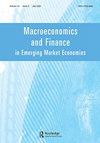银行监管、监督和贷款:来自特定撒哈拉以南非洲国家的经验证据
IF 1.1
Q3 ECONOMICS
Macroeconomics and Finance in Emerging Market Economies
Pub Date : 2022-10-20
DOI:10.1080/17520843.2022.2136396
引用次数: 2
摘要
摘要本研究调查了1995-2017年23个撒哈拉以南非洲国家及其中低收入群体的银行监管对银行信贷的影响。长期结果表明,严格的进入壁垒和监管权力减少了贷款,但监管权力减轻了进入壁垒的负面影响。此外,对进入壁垒的积极冲击对银行信贷产生了负面影响,而对资本要求的负面冲击对贷款产生了不利影响。从短期来看,对进入壁垒、活动限制和资本监管的积极冲击导致银行信贷增加,特别是在低收入SSA经济体。本文章由计算机程序翻译,如有差异,请以英文原文为准。
Bank regulation, supervision and lending: empirical evidence from selected Sub-Saharan African countries
ABSTRACT This study investigates the impact of bank regulation and supervision on bank credit in 23 Sub-Saharan African (SSA) countries and their low- and middle-income groups from 1995 to 2017. The long-run results indicated that stringent entry barriers and supervisory power reduced lending, but supervisory power mitigated the negative effect of entry barriers. Furthermore, positive shocks to entry barriers impacted negatively on bank credit, while negative shocks to capital requirements had an adverse impact on lending. In the short run, positive shocks to entry barriers, activity restrictions and capital regulations led to increases in bank credit, particularly in low-income SSA economies.
求助全文
通过发布文献求助,成功后即可免费获取论文全文。
去求助
来源期刊
CiteScore
2.40
自引率
7.70%
发文量
23

 求助内容:
求助内容: 应助结果提醒方式:
应助结果提醒方式:


